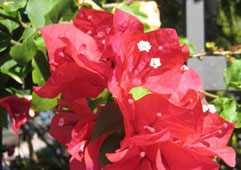Common Diseases & Problems
Fungal and Bacterial Leaf Spot (Pseudomonas and ropogonis)
The early symptoms are small reddish-brown leaf spots which usually occur on younger foliage, and cause the leaves to look "rusty". These enlarge into circular or irregular dark necrotic spots. When environmental conditions are drier and less favorable, leaf spots are slower to develop. Lesions have a tan center surrounded by a dark redbrown margin, and are sometimes bordered by a chlorotic halo. In time, leaf edges may become ragged as the necrotic tissue turns dry and papery. Under conditions of high rainfall or relative humidity the lesions develop quickly and are often black and vein delimited. Infection of developing leaves and bracts results in puckered, distorted growth.
Defoliation will occur when leaf spotting, blighting or marginal necrosis becomes severe.
Natural Control
Maintaining dry foliage is the primary control measure. Prune branches back and away from each other or, if just starting to grow, allow a large amount of space between them. Branches that are overlapping can't dry quickly and become more susceptible to leaf spot disease. Remove infected leaves and/or plants from the growing area.
Dispose of them immediately to reduce the spreading of infection.
Chemical Control
Spray fungicide in the spring if necessary. It will not cure infection that is already there, but it can control the spread of it. In frost-free climates where bougainvillea is perennial, disease incidence drops during cool and/or dry weather.
Leaf Drop
Problem as a result of over-watering, under-watering, low light levels, or cold temperatures.Leaf Spots
Yellow or tan spots appear on older leaves may be sign of Magnesium deficiency (common with yellow bougainvillea varieties), or from over-watering.Root Rot
Plants that are over-watered or subjected to water logged conditions can develop root or stem rot. Itís easily prevented by careful handling and by the application of a broad spectrum fungicide drench during transplanting or planting in the landscape.Scalloped Leaves
Snails, Slugs and Bougainvillea Looper CaterpillarYellowing or chlorosis on new growth
Often a result of a magnesium or iron deficiency, and an application of a complete micronutrient blend should help, but use caution--too much of either Mn or Fe will result in a secondary deficiency, as the plant is unable to absorb one when the other is present at high levels.Yellowing or chlorosis on old growth
Often a result of a magnesium or iron deficiency. Apply Epsom salts at 1-2 tsp/gal as a drench or foliar spray.Common Pests
A part of the bougainvillea’s appeal is that they are relatively disease and pest-free plants, but they can be affected by pests. Here is a list:- Aphids
- Bougainvillea Looper Caterpillar
- Leafminers: Moths, Flies, Beetles, Wasps
- Scale Insects: Parasites, Mealybugs
- Snails & Slugs
- Spider Mites
- Thrips
- Whitefly
Watch a video on pest control tips >

